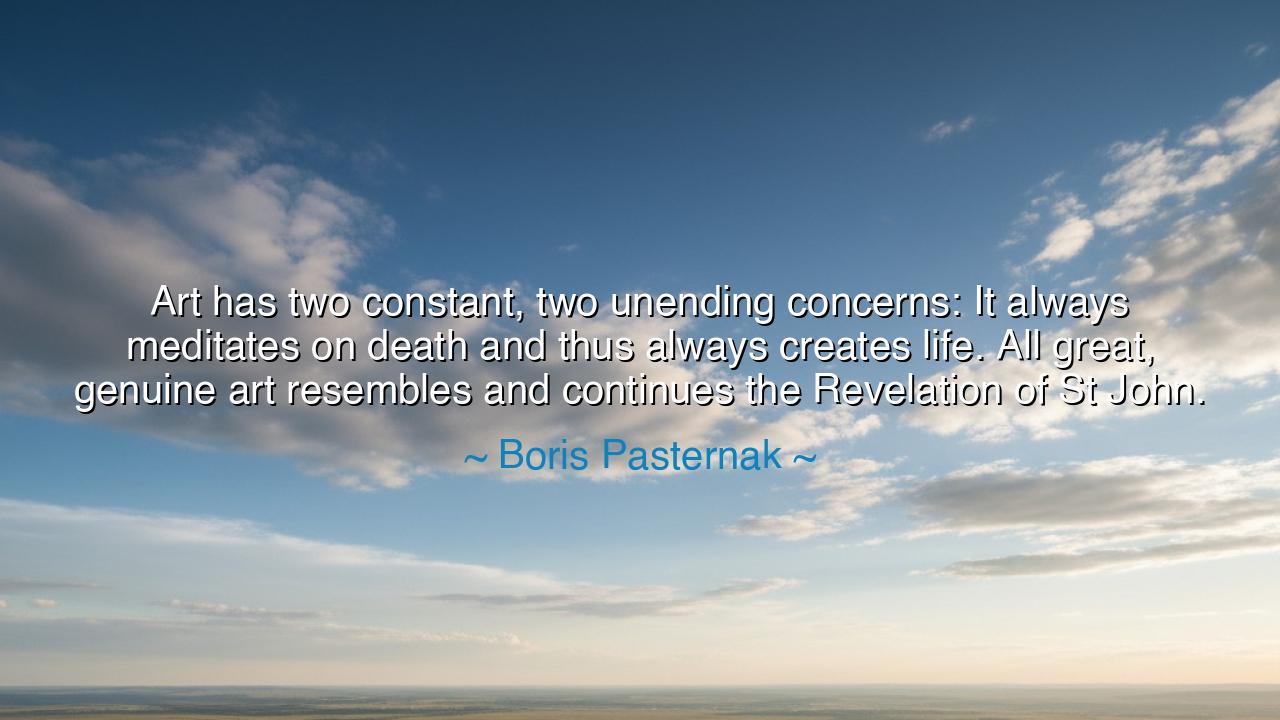
Art has two constant, two unending concerns: It always meditates
Art has two constant, two unending concerns: It always meditates on death and thus always creates life. All great, genuine art resembles and continues the Revelation of St John.






“Art has two constant, two unending concerns: It always meditates on death and thus always creates life. All great, genuine art resembles and continues the Revelation of St John.” So wrote Boris Pasternak, the poet and prophet of the human soul, whose words were forged in the fires of suffering and faith. Born into the turbulence of Russia’s storms, he saw empires rise and fall, and through it all, he clung to the eternal truth that art is both mortal and divine — that it looks upon death, yet gives birth to life. In these words, Pasternak speaks not only as an artist, but as a mystic, unveiling the sacred purpose of creation: that art, like revelation itself, transforms despair into light, and finality into resurrection.
When Pasternak wrote this, he was living in the shadow of tyranny. His homeland groaned under the weight of repression, and many of his contemporaries were silenced, imprisoned, or destroyed. Yet he continued to write — poems, letters, and his immortal novel, Doctor Zhivago — not as rebellion alone, but as a meditation on mortality and meaning. For he saw that the artist must look directly into the face of death: the death of freedom, the death of innocence, the death that stalks every living thing. But in contemplating it, he found the secret of eternal life through creation. For every poem written in the darkness was a seed of dawn. Every true work of art, he believed, is born in sorrow but lives in hope.
To say that art meditates on death is to say that it faces what others flee. The artist knows that time consumes all things — kingdoms crumble, faces fade, memories vanish — yet still, he dares to sing. In his song, death is not denied but transfigured. When Michelangelo carved the Pietà, it was not merely a mother mourning her son — it was humanity gazing upon its own fragility, and in that gaze, discovering compassion. When Beethoven, half-deaf and broken, composed his Ninth Symphony, he wrestled with despair and turned it into joy that would echo forever. Thus, art stands upon the border between ruin and renewal, reminding us that from the ashes of loss arises the beauty of meaning.
Pasternak’s second truth — that through its meditation on death, art creates life — is the eternal paradox of creation. To write, to paint, to compose, is to defy the silence of the grave. The artist, aware of his own mortality, gives voice to the timeless. In creating, he becomes both mortal and immortal — his body perishes, but his work lives on, breathing life into generations yet unborn. Just as spring follows winter, so does every true work of art awaken something eternal within us. That is why Pasternak compared great art to the Revelation of St John, the final book of the Bible — for there, amid fire and apocalypse, new heavens and new earth are promised. Art, too, passes through destruction to reach renewal. It sees the end of things, yet proclaims the beginning anew.
Think of Vincent van Gogh, who lived and died in obscurity, his mind tormented by visions and solitude. He painted the fields and stars as if they burned with the breath of the divine. His life ended in despair, yet his art became a fountain of joy to millions. Each brushstroke was a prayer — a dialogue between death and life, despair and hope. In his own suffering, van Gogh revealed what Pasternak meant: that art does not flee death, but redeems it. It transforms the anguish of existence into beauty, and in so doing, it allows humanity to live more deeply, more meaningfully, more awake.
In this way, Pasternak’s words also teach us about the purpose of the human soul. For every person, in some measure, is an artist — shaping their days, their choices, their loves, as one might shape a poem or a song. To meditate upon death is not to despair, but to recognize the preciousness of life. When we face our own impermanence, we begin to live with greater tenderness, greater gratitude, greater courage. Thus, Pasternak’s wisdom extends beyond the realm of art — it becomes a philosophy of living. He calls us to create beauty not only with pen or brush, but with our very being.
So let this teaching be inscribed upon your heart: do not turn from sorrow, for it is the soil of wisdom. Do not fear death, for through it, life finds its deepest meaning. Whether through art, or love, or labor, seek to create something that endures beyond yourself. Look upon the shadows, and then bring forth light. For as Pasternak wrote, all great art continues the Revelation — it unveils the truth that even in the world’s ending, the spirit of creation is reborn.
Therefore, live as an artist of the soul. Let your thoughts be your brush, your deeds your canvas, your compassion your song. In every loss, create love; in every silence, speak truth. For in so doing, you, too, will partake in that sacred cycle of which Pasternak spoke — the meditation on death that gives birth to life, and the everlasting creation that continues the divine Revelation through every human heart.






AAdministratorAdministrator
Welcome, honored guests. Please leave a comment, we will respond soon